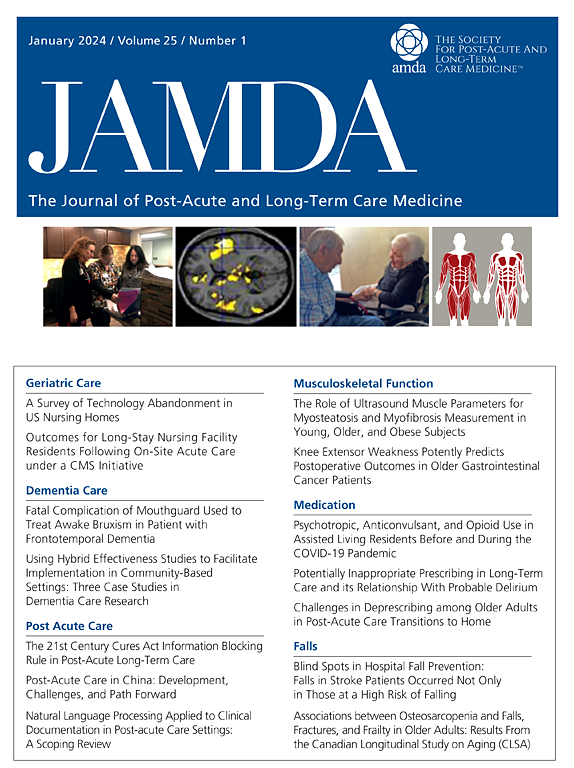家庭护理客户急诊就诊的预测因素、诊断和费用。
IF 3.8
2区 医学
Q2 GERIATRICS & GERONTOLOGY
Journal of the American Medical Directors Association
Pub Date : 2024-10-18
DOI:10.1016/j.jamda.2024.105308
引用次数: 0
摘要
目的:研究与家庭护理客户急诊就诊相关的因素、诊断和费用:研究与家庭护理客户急诊室就诊相关的因素、诊断和费用:设计:为期一年的前瞻性跟踪研究:需要更多有关居家护理客户到急诊室就诊的原因和相关费用的信息。参与者为居住在芬兰东部、年龄≥65 岁、定期接受家庭护理服务的人员(n = 293):收集的数据包括客户的人口统计学特征、健康状况(夏尔森合并症指数)、药物使用情况、身体(定时起立和走动)和认知功能评估(迷你精神状态检查)、基本和工具性日常生活活动、情绪(老年抑郁量表,GDS-15)以及与健康相关的生活质量(HRQoL,EuroQol [EQ-5D-3 L])。研究人员进行了逻辑回归和单变量方差分析。计算了急诊室就诊费用(总费用和每人每年费用):随访期间的急诊室就诊次数为 775 次(平均 350 天)。较好的 HRQoL 会降低 ED 就诊的可能性,而较高的 GDS-15 分数、较长的 TUG 时间、心衰病史和肾小球浸润减少则会增加 ED 就诊的可能性。急诊室就诊最常见的主要诊断是心力衰竭(8.4%)、心房颤动(4.0%)、呼吸道感染(4.0%)和膀胱炎(3.5%)。随访期间所有急诊就诊的总费用为 251,247 欧元,其中内科和外科的费用分别为 142,726 欧元和 89,212 欧元。每人每年的费用为 981 欧元:心身健康状况、抑郁症状、活动能力、心力衰竭和肾衰竭与急诊就诊次数有关。急诊室就诊最常见的原因是慢性心脏病和传染病,内科治疗的费用最高。通过预先制定护理计划、积极筛查症状以及家庭护理护士和医生的合作,部分急诊室就诊(如心力衰竭)是可以避免的。本文章由计算机程序翻译,如有差异,请以英文原文为准。
Predictors, Diagnoses, and Costs of Emergency Department Visits among Home Care Clients
Objectives
To examine factors, diagnoses, and costs associated with emergency department (ED) visits among home care clients.
Design
A prospective 1-year follow-up study.
Settings and Participants
More information is needed regarding the reasons and costs associated with ED visits by home care clients. Participants were persons aged ≥65 years living in Eastern Finland and receiving regular home care services (n = 293).
Methods
Data collection included clients’ demographics, health status (Charlson Comorbidity Index), medication use, assessments of physical (Timed Up and Go) and cognitive functioning (Mini-Mental State Examination), Basic and Instrumental Activities of Daily Living, mood (Geriatric Depression Scale, GDS-15) and health-related quality of life [HRQoL, EuroQol (EQ-5D-3 L)]. Logistic regression and univariate analyses of variance were conducted. The costs (total and per person-year) of ED visits were calculated.
Results
The number of ED visits was 775 during the follow-up (mean 350 days). The likelihood of ED visits was reduced by better HRQoL and increased by a higher GDS-15 score, longer TUG times, and a history of heart failure and decreased glomerular infiltration. The most common primary diagnoses for ED visits were heart failure (8.4%), atrial fibrillation (4.0%), respiratory infection (4.0%), and cystitis (3.5%). The total costs of all ED visits during the follow-up were 251,247 € and internal medicine and surgery accounted for 142,726 € and 89,212 € of the cost, respectively. The costs per person-year were 981 €.
Conclusions and Implications
HRQoL, depressive symptoms, mobility, and heart and renal failure were associated with the number of ED visits. The most common reasons for ED visits were chronic heart conditions and infectious diseases and the highest costs were incurred by internal medicine treatment. With advanced care planning and active symptom screening and cooperation of home care nurses and physicians, some of the ED visits, for example due to heart failure, might be preventable.
求助全文
通过发布文献求助,成功后即可免费获取论文全文。
去求助
来源期刊
CiteScore
11.10
自引率
6.60%
发文量
472
审稿时长
44 days
期刊介绍:
JAMDA, the official journal of AMDA - The Society for Post-Acute and Long-Term Care Medicine, is a leading peer-reviewed publication that offers practical information and research geared towards healthcare professionals in the post-acute and long-term care fields. It is also a valuable resource for policy-makers, organizational leaders, educators, and advocates.
The journal provides essential information for various healthcare professionals such as medical directors, attending physicians, nurses, consultant pharmacists, geriatric psychiatrists, nurse practitioners, physician assistants, physical and occupational therapists, social workers, and others involved in providing, overseeing, and promoting quality

 求助内容:
求助内容: 应助结果提醒方式:
应助结果提醒方式:


